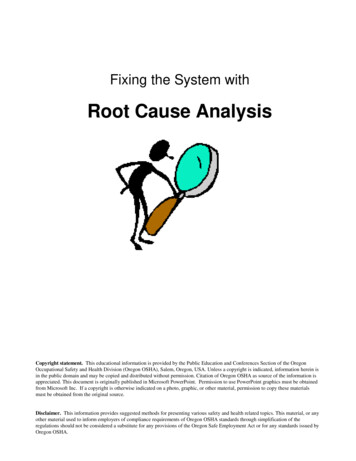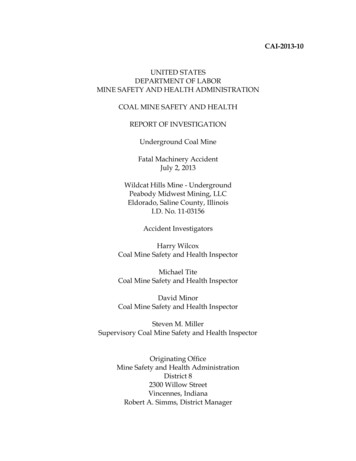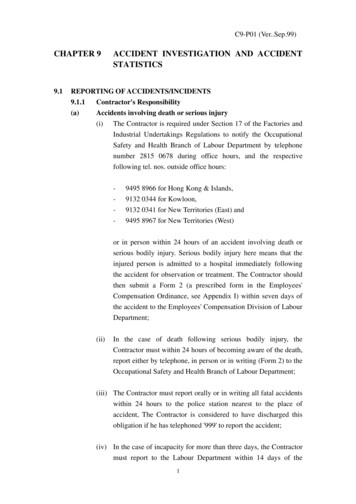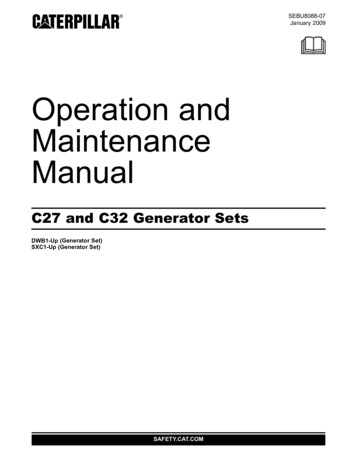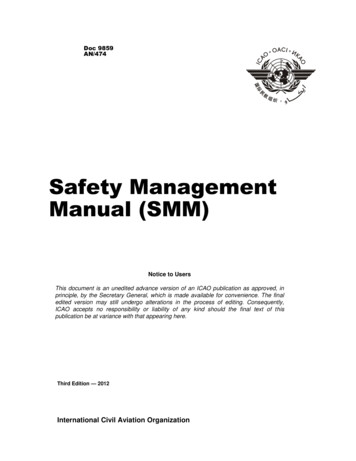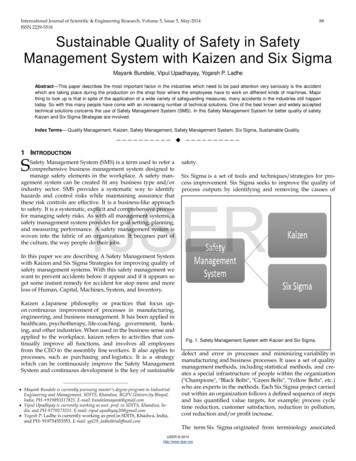
Transcription
Safety isNo AccidentA FRAMEWORK FOR QUALITY RADIATION ONCOLOGY CAREDEVELOPED AND SPONSORED BY
Safetyis NoAccidentA FRAMEWORK FOR QUALITYRADIATION ONCOLOGY CAREDEVELOPED AND SPONSORED BY:American Society for Radiation Oncology (ASTRO)ENDORSED BY:American Association of Medical Dosimetrists (AAMD)American Association of Physicists in Medicine (AAPM)American Board of Radiology (ABR)American Brachytherapy Society (ABS)American College of Radiology (ACR)American Radium Society (ARS)American Society of Radiologic Technologists (ASRT)Society of Chairmen of Academic Radiation OncologyPrograms (SCAROP)Society for Radiation Oncology Administrators (SROA)
TARG E T I NGC A NC E RC A REThe content in this publication is current as of the publication date. The information and opinions provided in the bookare based on current and accessible evidence and consensus in the radiation oncology community. However, no suchguide can be all-inclusive, and, especially given the evolving environment in which we practice, the recommendationsand information provided in the book are subject to change and are intended to be updated over time.This book is made available to ASTRO and endorsing organization members and to the public for educational andinformational purposes only. Any commercial use of this book or any content in this book without the prior writtenconsent of ASTRO is strictly prohibited. The information in the book presents scientific, health and safety informationand may, to some extent, reflect ASTRO’s and the endorsing organizations’ understanding of the consensus scientificor medical opinion. ASTRO and the endorsing organizations regard any consideration of the information in the bookto be voluntary. All radiation oncology medical practice management and patient care decisions, including but notlimited to treatment planning and implementation; equipment selection, maintenance and calibration; staffing andquality assurance activities, are exclusively the responsibility of duly licensed physicians and other practitioners, basedon relevant information not available to the authors. Neither this book nor its content is a substitute for professionalmedical advice, diagnosis or treatment. The ultimate determination regarding the practices utilized by each providermust be made by the provider, considering any local, state or federal laws and certification and/or accreditationstandards that apply to the provider’s practice, the applicable policies, rules and regulations of third-party payers, theirown institution’s policies, procedures, and safety and quality initiatives, and their independent medical judgment.The information and opinions contained in the book are provided on an “as-is” basis; users of the information andopinions provided by the book assume all responsibility and risk for any and all use. ASTRO and all the endorsingorganizations expressly disclaim all representations and warranties, expressed or implied, regarding the accuracy,reliability, utility or completeness of any information or other material provided here or in response to inquiry,including any warranty of merchantability and/or fitness for a particular purpose. Neither ASTRO, nor any endorsingorganization, nor any ASTRO or endorsing organization’s officers, directors, agents, employees, committee membersor other representatives, shall have any liability for any claim, whether founded or unfounded, of any kind whatsoever,including but not limited to any claim for costs and legal fees, arising from the use of this material.Copyright. American Society for Radiation Oncology. 2019. All Rights Reserved.
AcknowledgementsSafety is No Accident was first issued in 2012. The first edition of this book was based on an intersociety meeting where variousrepresentatives of sister radiation oncology societies came together to draft these safety recommendations. At the time, it was notedthat technologic advances and systemic changes in health care delivery meant that the field of radiation oncology and its processes ofcare are in continuous evolution. These changes must be reflected in this framework so timely review and revision was envisioned.In 2017, an effort to update the recommendations began by ASTRO’s Multidisciplinary Quality Assurance Committee (MDQA)that includes physicians, physicists, and other members of the radiation oncology team.A special thank you to the following MDQA members:Phillip Beron, MD, University of California, Los AngelesJoseph Bovi, MD, Medical College of WisconsinBonnie Bresnahan, RT, Anne Arundel Medical CenterDerek Brown, PhD, University of California, San DiegoBhisham Chera, MD, University of North CarolinaMichael Dominello, DO, Karmanos Cancer CenterSuzanne Evans, MD, Yale UniversityShannon Fogh, MD, University of California, San FranciscoGary Gustafson, MD, William Beaumont HospitalMark Hurwitz, MD, Thomas Jefferson UniversityAjay Kapur, PhD, Northwell Health SystemTeamour Nurushev, PhD, 21st Century OncologyMichael O’Neill, MD, Radiation Oncology Associates of LynchburgKelly Paradis, PhD, University of MichiganLakshmi Santanam, PhD, Washington UniversityJing, Zeng, MD, University of WashingtonMembers of the MDQA suggested revisions and then the revised draft was posted for comment to the sister societies, giving themthe opportunity to provide additional updates. The suggested revisions from the sister societies were reviewed by MDQA leadersand ASTRO’s Clinical Affairs and Quality Council leaders, Jim Hayman, MD, University of Michigan; Todd Pawlicki, PhD,University of California, San Diego; Benjamin Smith, MD, University of Texas MD Anderson Cancer Center; and Eric Ford,PhD, University of Washington. The revised draft was approved by the ASTRO Board in January 2019 and endorsed by sistersocieties by March 2019.
TABLE OF CONTENTSSafety Is No AccidentChapter 1. The Process of Care in Radiation Oncology11.1.PATIENT EVALUATION11.2.RADIATION TREATMENT 4.1.2.5.Clinical Treatment PlanningTherapeutic Simulation, Fabrication of Treatment Devices and Preplanning ImagingTherapeutic Simulation for External Beam Radiation TherapyTherapeutic Simulation for BrachytherapyDosimetric Treatment PlanningPreparation for Radiation Therapy Using Unsealed SourcesPretreatment Quality Assurance and Plan Verification22233441.3.RADIATION TREATMENT DELIVERY51.3.1.1.3.2.1.3.3.External Beam Radiation TherapyBrachytherapyCalibration Procedures, Ongoing Equipment Quality Assurance and Preventive Maintenance5571.4.RADIATION TREATMENT MANAGEMENT71.5.FOLLOW-UP EVALUATION AND CARE7Chapter 2. The Radiation Oncology Team82.1.ROLES AND RESPONSIBILITIES82.2.QUALIFICATIONS AND .Medical DirectorRadiation OncologistNonphysician ProvidersPhysicistDosimetristRadiation TherapistRadiation Oncology Nurse101010101010112.3.CONTINUING EDUCATION AND MAINTENANCE OF CERTIFICATION112.4.STAFFING REQUIREMENTS11
Chapter 3. Safety123.1.THE NEED FOR A CULTURE OF SAFETY123.2.LEADERSHIP AND EMPOWERING OTHERS123.3.EVOLVING STAFF ROLES AND RESPONSIBILITIES143.4.EXAMPLES OF TOOLS AND INITIATIVES TO FACILITATE SAFETYAND SAFETY 4.15.Staffing and SchedulesCommunication and FacilitiesStandardizationLean MethodsRisk AnalysisHierarchy of EffectivenessSystems and Human Factors EngineeringAutomated Quality Assurance ToolsPeer ReviewDaily Morning HuddlesSafety RoundsRoutine Public Announcements and UpdatesIncident LearningQuality Assurance CommitteeCredentialing and Training of Staff1414141515151616161818181818193.5.INGRAINING SAFETY INTO EVERYDAY PRACTICE193.6.COLLABORATION BETWEEN USERS AND VENDORS203.7.INVOLVING THOSE BEYOND RADIATION ONCOLOGY21Chapter 4. Quality Management and Assurancein Radiation Oncology224.1.QUALITY REQUIREMENTS FOR RADIATION ONCOLOGY .3.4.1.4.4.1.4.1.4.1.4.2.4.1.4.3.Physical Requirements for PracticesRadiation SafetyRadioactive Source ProceduresEquipment SafetySafety for Imaging DevicesProgram AccreditationMonitoring Safety, Quality and Professional PerformanceSafety, Quality and Error MonitoringMorbidity and Mortality RoundsMinimizing Time Pressures22232323232323242424
4.1.4.4.4.1.4.5.Monitoring Professional PerformancePeer Review4.2.PATIENT-CENTERED QUALITY MANAGEMENT254.2.1.4.2.2.4.2.3.4.2.4.4.2.5.General Medical IssuesPatient Access to Multidisciplinary Care and Technique SpecialistsOutcome AssessmentOutcomes RegistryQuality Assurance for the Standard Treatment Process25252626264.3.EQUIPMENT AND DEVICE QUALITY 3.7.2.Equipment, Devices and SystemsSystem Specification, Acceptance Testing, Clinical Commissioning and Clinical ReleaseProcess Quality AssuranceMaintenanceInterconnectivity and Interoperability of Devices and SystemsExternal ReviewEquipment Replacement, Upgrades and AdditionsExternal Beam Radiation TherapyQualification of External Beam Radiation Therapy PersonnelMinimum Device RequirementsMinimum Quality Assurance RequirementsIntensity-modulated Radiation Therapy and Volumetric-modulated Arc TherapyParticle TherapySpecialized Techniques and DevicesBrachytherapyQualification of Brachytherapy PersonnelMinimum Device RequirementsMinimum Quality Assurance RequirementsImaging DevicesCommissioning and Quality Assurance of the Treatment Planning and Delivery ProcessTreatment Planning SystemsMinimum Device RequirementsMinimum Quality Assurance RequirementsTreatment Management SystemsMinimum Device RequirementsMinimum Quality Assurance 353636363737374.4.DOCUMENTATION AND STANDARDIZATION384.4.1.4.4.2.Medical Record DocumentationPolicies and Procedures3838ReferencesAppendix I. AbbreviationsAppendix II. Illustrative Safety Staffing Model2525394546
2019 ForwardIn 2012, as part of its Target Safely initiative, ASTRO spearheaded the effort among our specialty societies toupdate the “Blue Book.” During the 20 years prior to its previous update, major advances had been made intreatment planning and delivery resulting in increased technical complexity. At the same time, cancer care wasbecoming much more multidisciplinary both within and outside our departments, resulting in the need forimproved communication. These issues, along with several others, led us to refocus our efforts to improve the qualityand safety of the care we deliver. The recommendations in Safety Is No Accident provided an updated framework forachieving that goal.Since 2012, many additional efforts have been undertaken by our specialty societies to improve quality and safety. Inthe last five years, with the support of several other societies, ASTRO has initiated the RO-ILS: Radiation OncologyIncident Learning System , one of the few specialty-specific national safety event reporting and shared learningsystems. ASTRO has also launched its Accreditation Program for Excellence (APEx ), a comprehensive programbased on a series of standards with a focus on continuous quality improvement. AAPM has also released reports andguidelines focused on quality and safety. For example, Task Group 263 focused on standardizing nomenclatures with akey goal to enhance future safety and quality efforts; Medical Physics Practice Guideline 4.a. focused on development,implementation, use and maintenance of safety checklists, and Task Group 100 focused on quality management andrisk assessment. At the same time, there have been major advances in our specialty including increased use of MRI andPET-based simulation, knowledge-based planning, re-treatment, hypofractionation, surface imaging and MRI-guidedtreatments, particle therapy and immunotherapy.In light of what we have learned from these new initiatives and advances, it is a logical time to update Safety is NoAccident to incorporate this new knowledge. Given the extent of the revisions undertaken six years ago, it is notsurprising that some updates have been made to clarify the standardization of routine processes and procedures.One major point of emphasis in this update is to make clear that quality and safety are not just the responsibility ofdepartmental leadership but the entire treatment team. Other areas where the bar has been raised involve certification ofdosimetrists and radiation therapists, radiation safety, and supervision of stereotactic treatments.Over the next five years, it is likely that emerging technologies will continue to become part of routine practice andresult in new unexpected challenges to quality and safety. In addition, we are entering an era where efficiency will beincreasingly important, requiring us to reassess the usual way of doing things and focus only on those activities thatadd value. Going forward, we need to take what we have learned about quality and safety, combine it with the mosteffective technologies and activities such as automation, simplification and standardization, and incorporate them into acontinuous quality improvement cycle to give our patients what they deserve, the best care possible.Todd Pawlicki, PhD, FASTROBenjamin Smith, MDJames A. Hayman, MD, MBA, FASTROEric Ford, PhD, FAAPM
2012 ForwardDuring the latter part of the twentieth century, the “Blue Book” had a unique importance in defining theshape of a modern radiation oncology department. It set standards regarding personnel, equipment andquality assurance and has been an invaluable guide for department chairs and practice leaders. Twenty yearshave elapsed since the last edition was published and during that time the world of radiation oncology haschanged beyond measure. These two decades have seen an unprecedented expansion in the technological tools at ourdisposal with clear benefits to our patients. At the same time, however, the “Great Expansion” has added the challengeof deep complexity to our planning and treatment delivery. These decades have also been associated with a vigorousawareness of safety in medicine generally and radiation oncology in particular. This movement is pushing the practice ofmedicine toward integrated teamwork and effective, simple, quality assurance procedures.The safe delivery of radiation therapy was never a simple matter and is now exceedingly complex. This new documentis designed to address the specific requirements of a contemporary radiation oncology facility in terms of structure,personnel and technical process in order to ensure a safe environment for the delivery of radiation therapy. It wasdeveloped through collaboration between all of the major societies in the field representing physicians, medical physicists,radiation therapists, medical dosimetrists, nurses and administrators. It explicitly sets a high bar below which noradiation oncology facility should operate, and it foresees that the bar will be raised further in the years ahead. This bookis unapologetic in its strong stance because, as the title states, safety is no accident. It comes from well-run facilities withgood processes operating harmoniously within their capabilities. We recognize that some with smaller facilities may findthe standards set here hard to achieve but we do not believe that they are impossible. We recognize that, in a decliningeconomy, these high bars may prove a challenge but we believe this interdisciplinary document will help facility leadersadvocate on behalf of patients from a position of strength. The authors wish this book to be a living manifesto of thespecialty’s dedication to patient safety and, after initial publication, will place it on the web with regular updating tofollow.Anthony L. Zietman, MDJatinder R. Palta, PhDMichael L. Steinberg, MD2011-2012 “Safety Is No Accident” Writing Chairmen
CHAPTER1TThe Process of Carein Radiation Oncologyhe “process of care” in radiation oncology refers toa framework for facilitating the appropriateness,quality and safety of all treatments received bypatients undergoing radiation therapy (RT).1The process of care can be separated into the following fiveoperational categories: Patient EvaluationRadiation Treatment Preparationo Clinical Treatment Planningo Therapeutic Simulation (simulation)o Dosimetric Treatment Planningo Pretreatment Quality Assurance (QA) and PlanVerificationRadiation Treatment DeliveryRadiation Treatment ManagementFollow-up Evaluation and CareA course of RT is a function of the individual patientsituation, composed of a series of distinct activities of varyingcomplexity. All components of care involve intense cognitivemedical evaluation, interpretation, management and decisionmaking by the radiation oncologist and other members of theclinical team. Each time a component of care is performed, itshould be appropriately documented in the electronic healthrecord (EHR).Other team members involved in the patient’s planning andtreatment regimen include the medical physicist (physicist),medical dosimetrist (dosimetrist), radiation therapist, nursingstaff and ancillary services. The radiation oncologist isresponsible for coordinating care with other specialists.Many of the procedures within each phase of care in radiationoncology should be completed before moving to the next phasein the patient’s care. Other processes will occur and recurduring the course of treatment for various reasons (e.g., patienttolerance to treatment, changes in treatment) as dictated bythe clinical scenario. Specific processes of patient care mayvary between practices. While the process of care involvesclose collaboration between a team of qualified individuals,the attending radiation oncologist is ultimately accountablefor all aspects of patient care. Most RT practices use standardoperating procedures (SOPs) to describe the treatmentapproach and provide consistent protocols for staff. TheseSOPs are an essential component of any practice. There willbe certain clinical scenarios which may require modificationof the SOPs to optimally treat the patient, and they shouldbe documented. Collaboration between clinical staff helpsdetermine how treatment options outside of an SOP might betailored to a particular patient’s situation.1.1. PATIENT EVALUATIONAt the request of another physician or patient, a radiationoncologist may be asked to evaluate the patient andThe clinical team, led by the radiation oncologist, providesthe medical services associated with the process of care.Safety is No Accident2019 1
recommend treatment or care for a specific condition/problem, including further work-up. As part of this process,the radiation oncologist obtains and reviews a clear, accurateand detailed description of the patient’s pertinent history,current and recent symptoms, physical findings, imagingstudies, pathology and laboratory results, as appropriate. Iftreatment is recommended, the goals of treatment, includingcurative or palliative intent, should be clearly establishedand discussed with the patient. The radiation oncologistand the patient (and family, as appropriate) should engagein shared decision-making about the appropriate course ofaction, including a detailed discussion of the treatment risksand benefits. Following the radiation oncologist’s evaluation,discussions with other members of the multidisciplinary careteam may ensue, as indicated. Potential combination andoptimal sequencing of treatment modalities, including surgeryand systemic therapy (e.g., chemotherapy, hormonal therapy,immunotherapy, or molecular targeted therapy) should beconsidered. All factors pertinent to treatment decision-making(e.g., prior radiation and/or systemic therapy, implanteddevices and pregnancy status) must be documented as partof RT preparation and made available to the clinical team.Full details of the patient evaluation and consent process arebeyond the scope of this safety document.21.2. RADIATION TREATMENTPREPARATIONof RT delivery (e.g., intensity-modulated radiation therapy[IMRT], proton beam therapy, intensity-modulated protontherapy, three-dimensional [3-D] conformal radiation therapy[CRT], two-dimensional [2-D] CRT, low-dose-rate or highdose-rate [HDR] brachytherapy, stereotactic radiosurgery[SRS], stereotactic body radiation therapy [SBRT]); specifyingareas to be treated, dose, dose fractionation and treatmentschedule. In developing the clinical treatment plan, theradiation oncologist may use information obtained fromthe patient’s initial clinical evaluation, as well as additionaltests, studies and procedures that are necessary to completetreatment planning. Studies ordered as part of clinicaltreatment planning may or may not be associated with studiesnecessary for staging cancer. Imaging studies and laboratorytests are often reviewed to determine the treatment volumeand relevant critical structures, commonly referred to asorgans at risk (OARs), in close proximity to the treatmentarea or more distant but receive radiation that needs to bemonitored. Toxicities and tolerances associated with theintent of treatment, including the time intervals between anyretreatment, should be evaluated.Clinical treatment planning results in a complete, formallydocumented and approved directive/order for simulation orany pretreatment preparation.1.2.2. Therapeutic Simulation, Fabrication ofTreatment Devices and Preplanning Imaging1.2.1. Clinical Treatment PlanningClinical treatment planning is a comprehensive, cognitiveeffort performed by the radiation oncologist and clinical teamfor each patient undergoing RT. The radiation oncologistis responsible for understanding the natural history of thepatient’s disease process, conceptualizing the extent ofdisease relative to the adjacent normal anatomical structures,and integrating the patient’s overall medical condition andassociated comorbidities. Knowledge of the integrationof systemic and surgical treatment modalities with RT isessential for appropriate care coordination in a safe and highquality multidisciplinary approach.Simulation is the process by which the patient’s anatomy isdefined in relation to the geometry of the treatment device todevelop an accurate and reproducible treatment delivery plan.For this purpose, radiographic and photographic images ofthe patient in the preferred treatment position are typicallynecessary. In general, the simulation procedure shows therelationship between the position of the target(s) and thesurrounding critical structures. For treatment techniques notrequiring dosimetric planning, volumetric simulation is notnecessary as the pretreatment preparation may be completedvia clinical setup and/or manual calculation.1.2.2.1. Therapeutic Simulation for EBRTThe simulation directive/order guides the procedureperformed by the radiation therapist(s). It is helpful tothink of the simulation step as the patient position andimaging needed to inform the dosimetric treatmentplanning process. Modern simulators, like the computedtomography (CT) simulator (less commonly magneticresonance or position emission tomography (PET)simulator), have the ability to produce volumetric datain addition to 2-D images. Intravenous, intracavitary orClinical treatment planning for all modalities (e.g., externalbeam radiation therapy [EBRT], brachytherapy or unsealedsources) is an important step in preparing for treatment.The timing of certain preparation components may varydepending on patient requirements and a practice’s preferenceand workflow. These components include: determining thedisease-bearing areas based on the imaging studies andpathology information; identifying the type and methodSafety is No Accident2019 2
oral contrast may be used during simulation to improvevisibility of both target and normal tissues/structures.Markers, such as wires, ball bearings or fiducials may beused to facilitate planning.Selecting a reproducible and appropriate patienttreatment position is an important part of the simulationprocess. The selected patient position should considerthe location of the target and anticipated orientationof the treatment beams as well as the comfort of thepatient. This may involve the construction or selectionof certain immobilization devices used to facilitatetreatment but should not restrict the treatment technique.A personalized approach is required, taking intoconsideration each patient’s unique anatomy and othercase-specific concerns to promote accurate treatment,provide support and enhance reproducibility. Somedevices (e.g., vaginal dilators/obturators, mouth opening/tongue position devices and prostate-rectal spacers) mayassist with reducing doses to adjacent normal tissue.Preparing for EBRT treatment can also depend onother imaging modalities that are directly or indirectlyintroduced in the simulation process. In some cases, extratime and effort are required to directly incorporate theinformation available from other imaging modalities.Treatment planning systems (TPS) that include imageregistration capabilities allow the fusion of multipleimaging modalities, such as magnetic resonance imaging(MRI) and/or PET, with the standard CT datasetobtained during simulation in appropriate situations. Inaddition, it is possible to produce image datasets thatquantify the motion of structures and targets due torespiration, cardiac motion and physiologic changes inthe body. These four-dimensional (4-D) datasets includetime as the fourth dimension and are used for motionmanagement techniques like respiratory tracking orgating. Other motion management techniques (e.g.,assisted or voluntary breath hold) may be used to helppromote accurate treatment delivery and these areconsidered and included during simulation as needed.studies taken with different patient positioning. TPS andsome CT-simulator devices can provide the software forthis capability. Use of TPS software shifts this part of theprocess to the dosimetric treatment planning phase withinthe overall care process. The radiation oncologist reviewsand verifies the accuracy of the fusion on the clinicallyrelevant region prior to proceeding to target delineationand normal tissue definition.1.2.2.2. Therapeutic Simulation for BrachytherapyFor certain brachytherapy procedures, treatmentpreparation is similar to the procedure described forEBRT. The simulation portion for this treatment modalityis also typically imaging based and can involve planarX-rays, CT scans, or ultrasound images, sometimes incombination with MRI scans. Other imaging modalitiesmay be important for some brachytherapy procedures;obtaining these studies is part of the preplanning imagingprocess.1.2.3. Dosimetric Treatment PlanningThe computer-aided integration of the patient’s uniqueanatomy, the desired radiation dose distribution to thetarget(s), dose constraints to normal tissues and the technicalspecifications of the treatment delivery device yield a workproduct referred to as the dosimetric treatment plan. The planis a programmed set of instructions for the linear acceleratoror brachytherapy device whereby a combination of externalbeams or internal source positioning administers the intendeddose of radiation to the target volume while limiting theexposure of normal tissues.Accordingly, before the dosimetrist begins the dosimetricplanning process, the radiation oncologist communicates anddocuments relevant clinical information and any additionalinstructions regarding treatment planning and treatmentdelivery in the planning directive/order. Additionally, theradiation oncologist has the following responsibilities: In some cases, patients require imaging from outsideof the radiation oncology practice. On such occasions,the exact patient positioning may not be duplicated forthese images and therefore clinical considerations shouldbe made to compensate for variations. Most imageregistration is still performed manually with rigid datasets.However, more practices are utilizing tools includingdeformable image registration for co-registering imaging Safety is No Accident2019 3Confirm registration, when applicable;Define the target volumes on the images obtainedduring simulation;Specify the normal tissues requiring segmentation;Specify dosimetric objectives and priorities for thetarget(s) and OARs;Identify patients with prior radiation history andother patient-specific considerations documentedduring the initial consultation; andDetail the total desired dose, fractionation, treatmenttechnique, energy, time constraints, on-treatment
imaging and all other aspects of the radiationprescription. In some cases, the prescription maybe modified based on the results ofthe treatment planning process.The dosimetrist and physicist must be appropriately trained inthe efficient and effective use of the complex TPS hardwareand software. They must also understand the clinical aspectsof radiation oncology in order to interact with the radiationoncologist during the planning process. Treatment planningtools are evolving, and various systems may be used tooptimize the treatment plan.The radiation oncologist reviews treatment plan(s) generatedduring the dosimetric planning process using a combination ofgraphic visual representations of the radiation dose distributioninside the patient and quantitative metrics describing the doseto the target(s) and OARs (e.g., dose-volume histograms). Theplan evaluation should include a review of OARs delineated byplanning staff for accuracy. Additionally, these plans may becompared against a documented standard, such as output froma knowledge-based planning system or practice’s protocol. Theradiation oncologist then decides whether to accept or reject agiven plan. This process may be iterative and require multiplerevisions and adjustments to the initial plan to achieve a dosedistribution that is both clinically acceptable and technicallyfeas
1.3.1. External Beam Radiation Therapy 5 1.3.2. Brachytherapy 5 1.3.3. Calibration Procedures, Ongoing Equipment Quality Assurance and Preventive Maintenance 7 1.4. RADIATION TREATMENT MANAGEMENT 7 1.5. FOLLOW-UP EVALUATION AND CARE 7 Chapter 2. The Radiation Oncology Team 8 2.1. ROLES AND RESPONSIBILITIES 8 2.2. QUALIFICATIONS AND TRAINING 9 2 .
